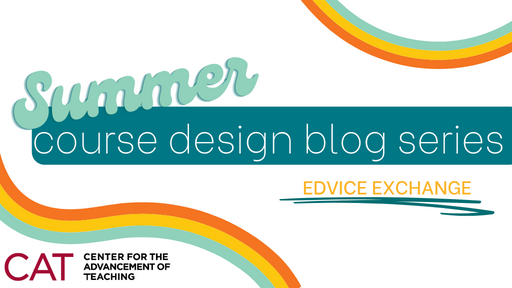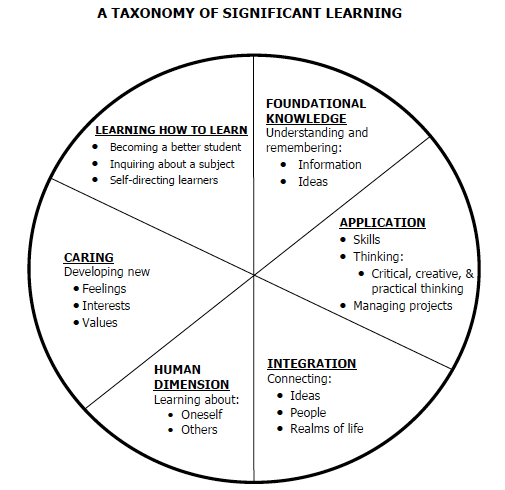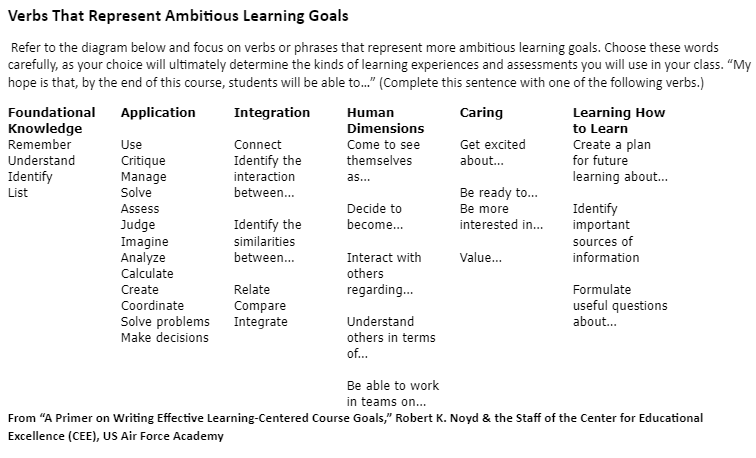Linda Hasunuma, Ph.D.

Take a close look at your syllabus. What do your learning goals (if you have them) say about what students are going to learn and achieve in your course? Often, our goals or course descriptions focus entirely on foundational knowledge and some application of that knowledge, but what about learning goals that go beyond facts, concepts, formulas, and theories? In this blog post, the third in our summer series on course design, we focus on how we can articulate learning goals that integrate our highest aspirations for learning and what Dee Fink calls our Big Dream for our students. What do we want students to take away, do, and remember years later from their time with us? Fink reminds us in his guide to creating courses for significant learning that we should lead our course design not with the content we will cover but instead with the goals we are hoping our students will reach.
So, what is your Big Dream and how can you craft that into a learning goal? Fink created a taxonomy to help you do just that. Fink’s Taxonomy of Significant Learning encourages instructors to think broadly about their goals for their students. A course goal might be focused on basic information you need students to know or on applying that foundational knowledge (the right side of the taxonomy), but goals focused on learning about oneself or others, or learning how to learn are equally important (the left side of the taxonomy). See below and think about where your current course learning goals are versus where you could go if you dared to dream big and include more of what is on the left side of his taxonomy. Most of us build goals in the foundational knowledge and application areas, but what can we do to include integration, the human dimensions, and caring into the learning experiences we create for our students?

By articulating goals that include more pieces of this pie, we can challenge ourselves to develop new and creative activities, assignments, and assessments that help our students make connections to one another and to the world. We can make our course content more meaningful to our students and their lives and can intentionally and thoughtfully build transformative and significant learning experiences.
The following questions can also help you brainstorm and draft learning goals so that we can aim to have students try to reach more of the goals on the left side of the pie:
- Big Dream: A year or more after this course is over, what do you want and hope your students will do?
- Foundational Knowledge: What key information (facts, formula, terms, concepts, relationships, etc.) is/are important for students to understand in this course or in the future?
- Application Goals: What kinds of thinking are important for students to learn (critical thinking, in which students analyze and evaluate; creative thinking, in which students imagine and create; and practical thinking, in which students solve problems and make decisions)? What important skills do they need to gain?
- Integration Goals: What connections (similarities and interactions) should students recognize and make in this course and with other courses or areas of learning? Or within their own personal lives?
- Human Dimension Goals: What could or should students learn about themselves and others?
- Caring Goals: What changes/values/passions do you hope your students will adopt?
- Learn how to learn goals: What would you like for your students to learn about how to be a good student, learn in this subject, and become self-directed learners, and develop skills for lifelong learning?
As we expand our understanding of learning goals to make them more ambitious and think about what we want students to actually DO, the verbs we choose to write the goals make all the difference in helping to create an authentic, transformative and significant learning experience. At the CAT, we suggest using Noyd’s 2008 table of verbs based on Fink’s Taxonomy as you think about developing, revising, or refining your own learning goals for your classes and students.

After brainstorming some draft goals, you may want to review them with a colleague to make sure they are effective and clear. Are your draft goals too narrow? Are they written in language your students will understand? Do they motivate and challenge your students? Which areas of the pie are represented in that learning goal? We don’t just teach content; we teach human beings. Though we may not have been encouraged to include the human and caring dimensions in our syllabi and courses during our own education and training, this framework and taxonomy remind us to keep the bigger picture in mind and to be bold in articulating our dreams for our students. Those dreams and hopes can be part of your learning goals!
Now that we have provided a framework for thinking about and designing your course and learning goals, we turn to assessments for the next post in this series. Working backwards from that Big Dream and our more ambitious learning goals, how can you evaluate learning and progress toward those goals?
References:
- Fink, Dee L. Creating Significant Learning Experiences: An Integrated Approach to Designing College Courses. San Francisco, Jossey-Bass, 2013 (pp.83-84).
- Noyd, Robert K. and the Staff of the Center for Educational Excellence, (white paper 08-01), A Primer on Writing Effective Learning-Centered Course Goals, 2008. Colorado Springs, CO. US Air Force Academy.
Linda Hasunuma serves as an Assistant Director at Temple’s Center for the Advancement of Teaching.